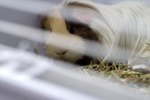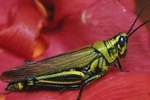The koala bear is a member of the taxonomic infra-class marsupialia. As in most marsupials, the reproductive systems of the koala are similar in form and function to those of placental mammals (mammals that have a placenta) with more differences in females. Koala reproduction has a short gestation period, followed by a premature birth. The koala newborn, then, receives extensive nourishment in the mother's external pouch, until it develops enough to live as an independent body.
Marsupialia

Marsupiala is a highly diverse group of mammals, commonly called marsupials. They are classified by a distinctive pouch, or marsupium. Marsupials share reproductive traits of both placental mammals and monotremes (egg-layers). Like placental mammals, marsupials have a live birth, rather than hatching from an egg; however, like monotremes, marsupials are nurtured by a yolk-sac.
Female Reproductive System

The female reproductive system of the koala is much different than that of placental mammals. Primary sex organs include two lateral vaginae and two ovaries, each with a corresponding oviduct, cervix and uterus. The two lateral vaginae are the receptacles for sperm, and they fuse together to act as a birth canal at the time of birth. The secondary sex organs are the mammary glands, which have nipples located in the marsupium. Koalas are able to produce distinct types of milk, simultaneously, for two suckling young at different stages of development. The mammary glands do this through a process called diapause.
Male Reproductive System

The male reproductive system of the koala is more similar both in form and function to that of placental mammals, with some notable differences. The scrotum lies in front of the penis rather than behind. The penis is split into two sections, complementing the two lateral vaginae of the female. When flaccid, the penis retracts into the body. Other functions, such as sperm and semen production, occur almost identically to those of placental mammals.
Gestation

Gestation is the period of time between conception and birth. The gestation period of a koala lasts for about 35 days. Unlike placental mammals, there is no nutrient exchange between the mother and the fetus. The embryo develops in a yolk-sac, which provides insufficient nutrients to completely develop the fetus. When born, the koala offspring, or joey, remains hairless, ear-less and with its eyes sealed shut.
Birth

Marsupials give birth to live young; however, young are birthed prematurely and are still unable to live independently from their mothers' bodies. The newborn joey, weighing less than six grams, crawls out of the mother's birth canal and into her marsupium. Here, it attaches itself to a nipple, where it will remain suckling and receiving nourishment until it is developed enough to enter the outside environment. The marsupium of the mother koala opens toward the back and has two nipples, the lowest number of all marsupials aside from the wombat.
References
Photo Credits
-
Ian Waldie/Getty Images News/Getty Images
Writer Bio
Justin Higgins has traveled throughout South America. He writes articles that appear on various websites with a focus on travel and science-related topics. Higgins is a graduate from Ithaca College with a Bachelor of Arts in cultural anthropology.



